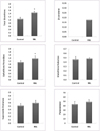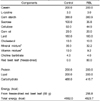1. Ames BN, Gold LS, Willett WC. The causes and prevention of cancer. Proc Natl Acad Sci U S A. 1995. 92:5258–5265.

2. Aprikian O, Levrat-Verny M, Besson C, Busserolles J, Rémésy C, Demigné C. Apple favourably affects parameters of cholesterol metabolism and of anti-oxidative protection in cholesterol-fed rats. Food Chem. 2001. 75:445–452.

3. Aviram M. Review of human studies on oxidative damage and antioxidant protection related to cardiovascular diseases. Free Radic Res. 2000. 33:S85–S97.
4. Bidlack WT, Tappel AL. Damage to microsomal membrane by lipid peroxidation. Lipids. 1973. 8:177–182.

5. Catapano AL, Maggi FM, Tragni E. Low density lipoprotein oxidation, antioxidants, and atherosclerosis. Curr Opin Cardiol. 2000. 15:355–363.

6. Dauchet L, Amouyel P, Hercberg S, Dallongeville J. Fruit and vegetable consumption and risk of coronary heart disease: A meta-analysis of cohort studies. J Nutr. 2006. 136:2588–2593.

7. Durrington PN, Mackness B, Mackness MI. Paraoxonase and atherosclerosis. Arterioscler Thromb Vasc Biol. 2001. 21:473–480.

8. Duthie GG, Bellizzi MC. Effects of antioxidants on vascular health. Br Med Bull. 1999. 55:568–577.

9. Duthie SJ, Ma A, Ross MA, Collins AR. Antioxidant supplementation decreases oxidative DNA damage in human lymphocytes. Cancer Res. 1996. 56:1291–1295.
10. Dyun MAS, Pivonka E. Overview of the health benefits of fruit and vegetable consumption for the dietetics professional: selected literature. J Am Diet Assoc. 2000. 200:1511–1521.
11. Fang YZ, Yang S, Wu G. Free radicals, antioxidants, and nutrition. Nutrition. 2002. 18:872–879.

12. Floreani M, Petrone M, Debetto P, Palatini P. A comparison between different methods for determination of reduced and oxidized glutathione in mammalian tissues. Free Radic Res. 1997. 26:449–455.

13. Folch J, Lees M, Sloane-Stanley GH. A simple method for the isolation and purification of total lipids from animal tissues. J Biol Chem. 1957. 226:497–509.

14. Gan KN, Smolen A, Eckerson HW, LaDu BN. Purification of human serum paraoxonase/arylesterase. Evidence for one esterase catalyzing both activities. Drug Metab Dispos. 1991. 19:100–106.
15. Habig WH, Pabst MJ, Jakoby WB. Glutathione S-transferases: the first enzymatic step in mercapturic acid formation. J Biol Chem. 1974. 249:7130–7139.
16. Hagen TN, Huang S, Curnutte J, Flower P, Martinez V, Wehr CM, Ames BN, Chisari FV. Extensive oxidative DNA damage in hepatocytes of transgenic mica with chronic active hepatistis destined to develop hepatocellular carcinoma. Proc Natl Acad Sci U S A. 1994. 91:12808–12812.

17. Jialal I, Norkus EP, Cristol L, Grundy SM. Beta-Carotene inhibits the oxidative modification of low-density lipoprotein. Biochim Biophys Acta. 1991. 1086:134–138.
18. Kanner J, Harel S, Granit R. Betalains - A new class of dietary cationized antioxidants. J Agric Food Chem. 2001. 49:5178–5185.
19. Kim JM, Kim DJ. The composition of dietary fiber on new vegetables. Journal of the Korean Society of Food Science and Nutrition. 2004. 33:852–856.

20. Lee JH, Felipe P, Yang YH, Kim MY, Kwon OY, Sok DE, Kim HC, Kim MR. Effects of dietary supplementation with red-pigmented leafy lettuce (Lactuca sativa) on lipid profiles and antioxidant status in C57BL/6J mice fed a high-fat high-cholesterol diet. Br J Nutr. 2009. 101:1246–1254.

21. Lee JH, Lee KT, Akoh CC, Chung SK, Kim MR. Antioxidant evaluation and oxidative stability of structured lipids from extravirgin olive oil and conjugated linoleic acid. J Agric Food Chem. 2006. 54:5416–5542.

22. Lichetnthäler R, Marx F. Total oxidant scavenging capacities of common European fruit and vegetable juices. J Agric Food Chem. 2005. 53:103–110.

23. McCord JC, Fridovich I. Superoxide dismutase. An enzymatic function for erythrocuprein. J Biol Chem. 1969. 244:6049–6055.
24. Mecocci P, Cherubini A, Polidori MC, Cecchetti R, Chionne F, Senin U. Oxidative stress and lymphocytes in Alzhemimer disease. Arch Gerontol Geriatr. 1998. 6:313–316.
25. National Institutes of Health. National Research Council, "Guide for the Care and Use of Laboratory Animals". 1996. Washington DC. USA: National Academy Press.
26. Nicolle C, Gueux E, Lab C, Jaffrelo L, Rock E, Mazur A, Amouroux P, Rémésy C. Lyophilized carrot ingestion lowers lipemia and beneficially affects cholesterol metabolism in cholesterol-fed C57BL/6J mice. Eur J Nutr. 2004. 43:237–245.

27. Nishimura N, Taniguchi Y, Kiriyama S. Plasma cholesterol-lowering effect on rats of dietary fiber extracted from immature plants. Biosci Biotechnol Biochem. 2000. 64:2543–2551.

28. Parthasarathy S, Santanam N, Ramachandran S, Meilhac O. Oxidants and antioxidants in atherogenesis: an appraisal. J Lipid Res. 1999. 40:2143–2157.

29. Petrozzi L, Lucetti C, Gambaccini G, Bernardini S, Dotto PD, Migliore L, Scarpato R, Bonuccelli U. Cytogenetic analysis oxidative damage in lymphocytes of Parkinson's disease patients. Neurol Sci. 2001. 22:83–84.

30. Pinto MC, Mata AM, Lopes-Barea J. Reversible inactivation of Sacchromyces cerevasiae glutathione reductase under reducing conditions. Arch Biochem Biophys. 1984. 228:1–12.

31. Riso P, Pinder A, Santangelo A, Porrini M. Does tomato consumption effectively increase the resistance of lymphocyte DNA to oxidative damage? Am J Clin Nutr. 1999. 69:712–718.

32. SAS Institute. SAS Statistics Software, release 8.2. 2000. Cary, NC. USA: SAS Institute.
33. Sepúlveda-Jiménez G, Rueda-Benítez P, Porta H, Rocha-Soda M. Betacyanin synthesis in red beet (
Beta vulgaris) leaves induced by wounding and bacterial infiltration in preceded by an oxidative burst. Physiol Mol Plant Pathol. 2004. 64:125–133.

34. Singh PN, McCoy MT, Tice RR, Schneider EL. A simple technique for quantitation of low levels of DNA damage in individual cells. Exp Cell Res. 1988. 175:184–191.

35. Siriwardhana N, Shahidi F, Jeon Y. Potential antioxidative effects of cactus pear fruit (Opuntia ficus-indica) extract of radical scavenging and DNA damage reduction in human peripheral lymphocytes. J Food Lipids. 2006. 13:445–458.

36. Stehbens WE. The oxidative stress hypothesis of atherosclerosis: cause or product? Med Hypotheses. 1999. 53:507–515.

37. Sulli KC, Sun J, Giraud DW, Moxley RA, Driskell JA. Effects of β-carotene and α-tocopherol on the levels of tissue cholesterol and triglyceride in hypercholesterolemic rabbits. J Nutr Biochem. 1998. 9:344–750.

38. Tanaka K, Miyazaki I, Fujita N, Haque ME, Asanuma M, Ogawa N. Molecular mechanism in activation of glutathione system by Ropinirole, a Selective Dopamine D2 Agonist. Neurochem Res. 2001. 26:31–36.
39. Tappel AL, Fleischer S, Packer L. Glutathione peroxidase. Methods Enzymol. 1978. 52:506–523.
40. Teow CC, Truong VD, McFeeters RF, Thompson RL, Pecota KV, Yencho GC. Antioxidant activities, phenolic and β-carotene contents of sweet potato genotypes with varying flesh colours. Food Chem. 2007. 103:829–838.

41. Tesoriere L, Butera D, D'arpa D, Gaudio FD, Allegra M, Gentile C, Liverea MA. Increased resistance to oxidation of betalain-enriched human low density lipoproteins. Free Radic Res. 2003. 37:689–696.

42. Urso ML, Clarkson PM. Oxidative stress, exercise, and antioxidant supplementation. Toxicology. 2003. 189:41–54.

43. Vinson JA, Hao Y, Su X, Zubik L. Phenol antioxidant quantity and quality in foods: vegetables. J Agric Food Chem. 1998. 46:3630–3634.

44. Wu G, Fang YZ, Yang S, Luption JR, Turner ND. Glutathione metabolism and its implications for health. J Nutr. 2004. 134:489–492.










 PDF
PDF ePub
ePub Citation
Citation Print
Print




 XML Download
XML Download